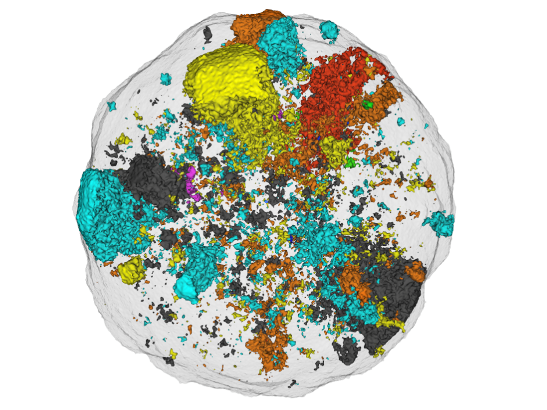
Image: Dr Andrea Sottoriva working on a computational model.
Scientists have developed a complex mathematical model that uses a snapshot of tumours’ genetic code to reach back in time, revealing its evolutionary history.
The researchers – mathematicians and computer scientists at The Institute of Cancer Research, London, the Barts Cancer Institute and University College London – have used it to develop a computer program that predicts how individual cancers will evolve in the future.
The model uses a variety of formulae to apply the theory of evolution to big datasets of genetic information taken from tumour samples.
It opens up the possibility of predicting the chance of cancer cells with a particular genetic change, or mutation, taking over a tumour.
Our Centre for Evolution and Cancer aims to help us understand how cancer evolves and adapts, and to find more effective ways to treat it.
Learning the rules of cancer evolution
In the study, published in Nature Genetics, the scientists applied their model to genetic samples from a variety of cancer types – including breast, gastric, blood, colon and lung cancers, and secondary tumours that had spread from primary sites.
By analysing the pattern of mutations in the DNA of the tumour cells, the computer program was able to ‘learn’ key features about the changing genetic make-up of the cancer in the past – a ‘diary’ of which genetic characteristics have been dominant in its history.
The computer program then used the historic pattern of genetic change to learn the rules of evolution for specific tumours, forecasting how they will change in the future.
In the future, the model could allow for personalised projections about the future growth of cancers.
Other parameters could be added to the model to make it more accurate, such as considerations of spatial factors – like the proximity of blood supply to some areas of tumours – which can affect the likelihood that cancer cells with ‘nasty’ genetic characteristics might become a dominant force in a tumour.
By understanding which mutations are thriving or in decline, the model could help tailor a person’s treatment to anticipate future changes, or inform how often a cancer should be sampled to advise on the best treatment options.

Image: A model of the pattern of mutations in the DNA of tumour cells. (Credit: Dr Andrea Sottoriva)
New tools to 'anticipate' how a cancer will change
The study was funded by the Wellcome Trust and Cancer Research UK.
Study co-leader Dr Andrea Sottoriva, Chris Rokos Fellow in Evolution and Cancer, and Team Leader in Evolutionary Genomics and Modelling at The Institute of Cancer Research, London, said:
“Our study marks a big step forward in our efforts to make tools that, in the same way as we can predict the weather, anticipate how a cancer will change in the future.
“We used mathematics to set the ground rules from which we developed a new computer program that learns the rules of evolution for individual tumours, and uses these rules to project what will happen in the future course of a patient’s disease.
“In the future, we hope tools like this one will enable doctors to predict the evolutionary trajectory of cancer in individual patients and change and adapt therapy according to their cancer’s next step.”
Study co-leader Professor Trevor Graham, Professor of Cancer Evolution at the Barts Cancer Institute, said:
“As cancers grow, they change and evolve over time. Our research lays the groundwork to forecast how cancer changes in individual patients in a way we’ve not been able to do before. It has the potential to have major implications for predicting prognosis – helping doctors to ‘stay one step ahead’ of the disease.”
